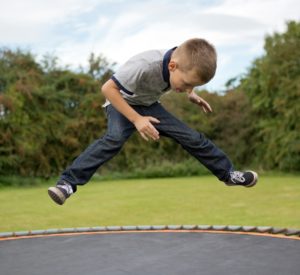 A trampoline is essentially a device that people bounce on for competitive and/or recreational purposes. It comprises of taut, strong material that is stretched over a metallic frame using several coiled springs.
A trampoline is essentially a device that people bounce on for competitive and/or recreational purposes. It comprises of taut, strong material that is stretched over a metallic frame using several coiled springs.
Trampolines help users of all ages in the following ways; stimulate metabolism, makes the muscles more firm, enhances the circulation of oxygen, gives a sense of vitality, increases energy levels, improves the sense of balance, makes the heart stronger, enhances the circulation of oxygen to body tissues and also enhances the circulation of lymph.
Buying guide
There are several factors that you ought to consider when choosing a trampoline. They include;
- Shape (do you need a device that is round, square, oval, or rectangular in shape?)
- Availability of safety features
- Measurement (width and length of jumping space)
- Bounce effect
- Height of the frame
- Intended use
- Materials used in construction
Types of trampolines
Trampolines can be broadly classified into two categories; recreational and competitive.
Recreational trampolines can be further classified into two; for commercial use and for use at home. Some additional types can be found here at the best trampoline reviews.
The former are usually installed indoors and stretch from one wall to another to ensure people don’t fall off them onto hard surfaces. They usually comprise of springs or pads to ensure users don’t sustain impact injuries.
On the other hand, home trampolines have weaker springs and are also less sturdy than the commercial versions. They can either be circular, rectangular or octagonal in shape.
Trampolines can also be classified as; round, mini, rectangular, in-ground, square, octagonal, spring less and inflatable.
Materials used
Trampolines are usually constructed using either woven polypropylene or water-proof canvas.
Safety features
Ideally, a good trampoline must consist of the following safety features;
- Enclosure net
- Approval label
- Spring pads
- Clearance
- Frame
1. Enclosure net
This is an important safety feature that ensures users do not fall off and get hurt. Weaves used to make the enclosure net must be sufficiently tight to ensure toes and fingers do not get trapped. The net ought to be attached using button-hole systems, threaded ropes or clips.
2. Approval label
Do not purchase a trampoline that isn’t duly approved by governing bodies that are concerned with the safety of trampoline and other related devices. If you are in the USA, it must be approved by the ASTM.
3. Spring pads
Are you aware that uncovered trampoline springs are a safety hazard? Trampolines must therefore comprise of pads located either outside or inside the enclosure nets. They must be resistant against UV rays. Additionally, they must be thick to ensure maximum protection.
4. Clearance
When choosing a trampoline, you must consider the required amount of clearance both around and above the device. Ideally, there ought to be clear space of about 24 feet above the ground.
5. Frame
A frame is an important safety feature that must be considered when choosing a trampoline. Height of the frame must be commensurate to the height of users. The frame should be made of powder coated steel or galvanized steel.